






Changes to our Global Harmonisation System (GHS) chemical regime applying from 30 April 2021 require accurate and timely advice - non-compliance could prove costly.
Competent staff avoid expensive and sometimes confusing compliance advice, while enabling an effective response to chemical incidents, often without requiring emergency services.
Inspectors and certifiers with years of expertise warn of a declining national workplace chemical safety performance.
A crucial factor is the continuing loss of onsite chemical safety advice, primarily due to replacing flawed but effective mandatory Approved Handlers with whatever employers now deem sufficient.
A second major chemical incident in the same public facility is a timely reminder that safe chemical management is not receiving the attention it deserves. Competent staff are essential.
Onsite Responsible Care NZ (RCNZ) Competent Chemical Handler
Certification courses are tailored to reflect your chemical inventory and enable compliance.
Upskill the last of your HSNO Approved Handlers, update Certified
Handler requirements and successfully implement the updated Global Harmonisation System (GHS).
For struggling, noncompliant business operators who are attracting attention from enforcement agencies, practical onsite advice from Competent Chemical Handlers helps lessen the load on a diminishing number of Compliance Certifiers. It helps to ensure site chemical safety measures remain effective.
RCNZ Competent Chemical Handlers (CCH) are increasingly in demand, resulting from our popular ‘Walk and Talk’ site visit to assess actual chemical management performance, identifying the need for specialist training, throughout the product life cycle.
Chemical incidents now guarantee media attention, often sensationalising the incident by highlighting persons adversely affected by unwanted exposure to chemicals.
This can irretrievably damage reputations to both customers and suppliers, particularly if employers have not taken all practicable steps to safely manage their chemical inventory throughout their operations.
When chemicals do cause problems, employees, customers, WorkSafe
Ensuring staff are competent to safely manage the harmful chemicals essential to your business includes your effective response to a chemical incident.
To enable a smooth, cost-effective transition to and beyond compliance, you need compliance tools:
- the updated RCNZ industry Codes of Practice reflecting our revised GHS chemical management system
- your 24/7 CHEMCALL® emergency response subscription; and the all-important ‘how to’ advice arising from our popular site ‘walk and talk’ assessments
- replacing your Approved Handler with our Competent Chemical Handler certification
These are all cost-effective measures which add value to your business. Talk to us today about compliance tools, which confirm you are a good employer, committed to safeguarding employees and our environment by safely managing your chemical inventory.
Responsible Care NZ
04 499 4311
www.responsiblecarenz.com
inspectors, local authorities, health protection officers and emergency response organisations all benefit from the expertise and product safety information available 24/7 from 0800 CHEMCALL®, our industry’s unique, subscription based chemical emergency advisory service.
Supported by thousands of compliant Safety Data
Sheets (SDS) combined with their collective industry expertise and local knowledge, CHEMCALL® responders provide callers with comprehensive advice about how to safely manage the incident, safeguarding people and often avoiding business disruption.
For many people, career advancement does not always mean climbing the corporate ladder, a Randstad report finds
To be seen as aspirational places to work, Randstad Chief Executive Sander van ‘t Noordende says employers need to embrace the idea of working in much closer partnership with talent, not only by developing their careers but also by building equitable workplaces where workers feel they belong.
“Organizations must demonstrate that they truly understand workers’ ambitions, their desire for balance and the need for connection. Only then will they be able to attract and retain the talent they need to realize strategic business goals in an environment of rapid change.”
Randstad’s latest findings in its Workmonitor 2024 report look at the global working population with learnings that can be converted into actionable strategies that will drive tomorrow’s talent agenda, he says.
The report finds that a new talent ABC is emerging:
• A stands for ambition: talent is rethinking what ambition means, putting work-life balance, flexibility, equity and skilling at the heart of career decisions.
• B stands for balance: personal lives are being prioritized over careers by talent.
• C stands for connec-
tion: employers must rekindle connections with workers to understand their needs and desires.
Ambition is more than climbing the career ladder and talent’s motivation is not necessarily driven by promotions.
For nearly two-thirds of
Employers’ talent strategies will need to acknowledge these changing priorities and offer more creative paths to progression that align with the different ambitions of their talent.
Talent still demands and seeks flexibility to accommodate all of their priorities.
The importance of work-

respondents (60%), their personal lives are more important than their work lives. Work-life balance now ranks as highly as pay on workers’ lists of priorities (93%) — more than any other considerations. When looking at their next career move, work-life balance is even more important (57%) than higher pay (55%).
Over a third don’t want career progression because they are happy in their role (39%), and the long-term ambition for most respondents is a stable in-house role. But that does not stop them from wanting to future-proof their skills through training (72%), especially in areas such as artificial intelligence (AI) and IT, which are reshaping job roles.
life balance is also reflected in a continued focus on flexible working, even as employers are increasingly advocating a return to the office. Many workers adjusted to the work-from-home lifestyle over the pandemic years — moving further afield or getting a pet — as they expected remote working to stay.
Working from home is non-negotiable for close to 2 in 5 respondents. Similar numbers (37%) would consider quitting if they were forced to spend more time in the office.
However, there is a nuance when it comes to making their next career move: wanting flexible working hours edges slightly ahead of the need to work from home (41% vs.
37%).
Talent is looking to build connections with employers so that they can present their full selves and work with organizations to improve equity in the workplace.
Over a third say that they wouldn’t accept a job if they did not agree with the views of the organization’s leadership (38%), with 54% of respondents considering their employer’s stance and actions on social and political issues important.
Meanwhile, almost twofifths (38%) seek alignment on social and environmental issues with a future employer.
Talent continues to prioritize the future-proofing of their skills, particularly in light of the widespread adoption of AI. Despite more complex attitudes to career progression and ambition, there is a continued thirst for training and development in both current roles and for future career moves (72%). Around a third (29%) would even go as far as quitting a job that didn’t offer adequate learning and development (L&D) opportunities.
Respondents see the responsibility for training and development residing with both them and their employers, again underlining the connection theme that runs through the entire survey.
randstad.com





The National Health & Safety Leaders’ Summit, set to unfold in 2024, promises a dynamic exploration of the latest developments, trends, and challenges in the ever-evolving landscape of workplace health and safety.
On the Plenary Day One of the Summit, an impressive lineup of speakers is poised to deliver critical insights and practical strategies to safety leaders navigating the complexities of their roles.
Kicking off the summit, Robyn Bennett, President of the New Zealand Institute of Safety Management, will spearhead discussions on the latest trends in health & safety management. From changing market conditions to economic shifts and workplace trends, Bennett will shed light on how these factors impact safety leaders. Emphasizing a redefined business ecosystem with a focus on worker safety and wellbeing, she will draw lessons from recent highprofile workplace health and safety challenges.
Following Bennett, Steve Haszard, Chief Executive of WorkSafe, will deliver a keynote addressing
organizational change and expected responses within the health & safety sector. He will delve into the impact of WorkSafe’s new strategy on safety leaders and elucidate how performance measurement mechanisms will shape the sector's future.
Christian Hunt, Founder of Human Risk Ltd, brings an international perspective to the summit. His keynote will explore driving transformation in organizational culture to embed safety. By delving into the interface of culture, human factors, and behavioural science, Hunt aims to provide actionable strategies for fostering continuous improvement in safety culture.
Derek Toner, Director of Engaging Solutions, will share insights on driving culture change by engaging with leadership and front-line teams.
Toner will emphasize the pivotal role of visibility in culture change and the responsibilities of safety
leaders in co-designing safer working practices.
Moira Loach, Senior Health & Safety Advisor, and Jodhi Warwick-Ponga, Board Trustee, will introduce the Haumaru Tāngata (Māori Health & Safety) Framework. Addressing the overrepresentation of Māori in workplace statistics, they will outline the framework’s components and application in workplace health & safety initiatives.
Grant Nicholson, Partner at Anthony Harper, will discuss the evolving legal landscape of health & safety in New Zealand, highlighting recent legislation, regulatory changes, and court cases. The summit will also feature a panel discussion on the role of health & safety leaders in critical incidents, and insights from Women In Safety Excellence NZ on shaping the future of health & safety.
In essence, the National
Health & Safety Leaders’ Summit promises a comprehensive journey through the nuances of health and safety leadership, providing attendees with actionable insights and strategies to enhance workplace safety and wellbeing.
Attendees can tailor their conference experience with Day Two Streams For safety leaders traversing the dynamic intersection of technology and safety you can attend Stream A which will focus on emerging technologies; including trends that leverage AI to enhance safety through virtual reality.
Wellbeing at work is on the radar for many organisations and Stream B will delve into topics ranging from psychological health and safety obligations to preventing worker burnout and promoting resilience at work.
The event will be held on 19-20 March at the Ellerslie Events Centre in Auckland and you can view the programme at brightstar. co.nz/safety


19 - 20 MARCH 2024 ELLERSLIE EVENTS CENTRE, AUCKLAND
Critical insights for leaders to improve workplace safety & wellbeing
DAY 1 : 19 MARCH
Plenary Stream
DAY 2 : 20 MARCH
Choose between: OR
STREAM A Innovation & Technology in Health & Safety
STREAM B Health & Wellbeing at Work
brightstar.co.nz/safety







Professor Alex Haslam from the university’s School of Psychology led research into ideas about leadership which are still popular despite being harmful for individuals, groups, and organisations.
“It’s known as ‘zombie leadership’ because despite being demonstrably false, these claims refuse to die,” Professor Haslam says.
“One example is the assumption that leadership is exclusive to people with special qualities which set them apart from the masses.
“Zombie leadership also considers authority as only involving leaders.
“But leadership can
never be a solo process because it’s always grounded in relationships and connections between leaders and those they influence.”
Other problematic examples include the idea that all leadership is the same, that good leadership is easily recognised, that people can’t cope without leaders and that leadership is always good.
Professor Haslam says zombie leadership has no empirical support, but lives on because it flatters and appeals to elites and to the anxieties of ordinary people in a world seemingly beyond their control.
“Zombie leadership is
poisonous for organisations and society.
“If leadership is considered a special skill limited to special people, it signals it as an elite and exclusive activity, and helps to justify inequalities of esteem, recognition, and reward.
“This creates problems not only for organisations, but for leaders themselves — because it fuels narcissism and failure to appreciate and capitalise on the potential of others.”
The research outlines strategies that can be used to overcome zombie leadership.
“People first need to understand what zombie
leadership is, so they recognise when they come across it,” Professor Haslam says.
“Understanding leadership as a group process can help leaders be more inclusive.
“And then championing an approach which sees leadership as a process everyone can contribute to will make groups more successful.
“It’s time to work together to stamp out zombie leadership, because it has persisted for far too long.”
The research paper is published in The Leadership Quarterly.
Historically, New Zealand has lagged behind international trends in the use of human scientists from this field, but this is now changing – with demand growing rapidly since the pandemic.
New Zealand businesses are increasingly turning to anthropologists to address systemic workplace cultural issues or help navigate periods of change.
Many sectors of the economy are struggling to attract and retain staff with latest Government data showing a critical skills shortage in the manufacturing and engineering sectors is set to grow by 38% to 40,000 workers by 2028.
The impact of the pandemic has been manifested as a flip in the business model where people have realised they now have the upper hand. Employees now understand they have got the choice of where they work, when they work and what they work for.
As a result, I don’t have a single client anywhere in the world that isn’t under the pump trying to attract new talent in.
While anthropology is the study of humanity with the goal of understanding our evolutionary origins and our distinctiveness as a species, a corporate anthropologist assists companies in better understanding their customers, along with the differing cultures within a business and how to create high performing individuals and teams.
The use of anthropologists is common among multinational tech companies, including Google, Intel, Xerox, and IBM – with Microsoft believed to be the second largest employer of anthropologists in the world.
While we know companies such as Google have almost

With the labour market becoming more competitive, employers are turning to anthropologists to create an optimum environment for employee attraction and retention, says corporate anthropologist Michael Henderson
50 full time anthropologists on staff, in the Southern Hemisphere it is more common for businesses to work with organisational psychologists.
While psychologists primarily work with the brain and how individual personalities or profiling influences their behaviours, an anthropologist looks at the interactions of individuals and a group – including the unspoken components of behaviours.
The need for intensive
leadership is reduced when an organisation has a culture which ensures staff are aware of the company’s strategy.
We know that when people understand the environment they’re operating in, what’s required of them and what’s required of the business in the marketplace, then the need for leadership’s role, influence and oversight is diminished significantly.
While culture can’t be measured, the output of
what it delivers can.
The realisation that culture isn’t linear or binary is a big learning for businesses. The first thing we tell organisations is that they can’t apply measurements to an intangible concept such as workplace culture and that while cultures aren’t measurable, they are meaningful.
The primary role of culture is to establish what is meaningful for us and what motivates us to behave in a certain way.

Employers who tell their employees to ‘leave their personal problems at home’ may be contributing to a more hazardous workplace by increasing the risk of serious, even fatal, accidents on site, a health and safety service provider says
Stats NZ reports a significant increase in the proportion of people with poor mental well-being, up from 22 per cent in 2018 to 28 per cent in 2021. How this impacts broader health and safety—for example, falls and accidents with machinery, power tools and forklifts—is a significant concern.
Mental health issues cause distraction and anybody working on a construction or manufacturing site, among others, cannot
afford to be distracted, says +IMPAC Health and Safety trainer Maxine Bowring.
“There’s no data on what contribution mental health makes to workplace incidents because people can keep it hidden. Nobody may know that the person involved in an accident, for example, is going through a divorce, is trying to deal with excessive work-related stress, or having financial anxieties.
A study by Tatauranga Aotearoa (StatsNZ) called
New Zealanders’ Mental Wellbeing Declines, reports that the portion of people with poor mental wellbeing equates to more than a quarter of the population.
Mental health first aid programmes increase mental health literacy in workplaces and give people the understanding and confidence to talk about depression, anxiety and suicide.
New Zealand has one of the worst suicide rates amongst OECD countries, especially of young men
(males are more than twice as likely to die from suicide than females), and particularly high for Māori males aged 15–44 years.
“Having somebody there to listen and offer support makes a significant difference,” Bowring says.
“Having somebody in the workplace who can recognise the signs, offer a quiet word, a genuine conversation, and encourage them to seek professional help and support can save lives and help prevent workplace
accidents.
“There is always somebody in the workplace that people seem to trust enough to take into their confidence — these are the people who will make ideal Mental Health First Aiders,” Bowring says.
Mental Health First Aiders are trained to approach, assess and assist. The process involves listening without judgement, providing information and support and encouraging the struggling person to seek professional help.
“Very often, people can see something is wrong, but they don’t know how to open the conversation. The title, qualification, and tools to open conversations will better position them to open up sensitive conversations with fellow workers.
“Mental health is not a visual thing. You cannot see what’s going on in somebody’s head. We assume everybody thinks and copes as we do, but we are all wired differently. Different genetics, different lives.”
Christchurch-based +IMPAC Health and Safety consultant and trainer, Louise Trevella, says unlike most health and safety training, people need a clearer picture of the risk in the workplace when it comes to mental health.
“Falling is a critical risk for people working at height, but with a number of known excellent controls around that activity, the likelihood of falls is reduced. Control measures can be applied when leaders understand the critical threat to their people.
“With mental health and suicide, people don’t clearly understand the risk—the hazard is not visible and they often don’t know what to do if they suspect there are mental health issues
affecting one of their team.
“You can tell people to leave their problems at home, but that’s not going to happen. People bring their mental health issues, challenges and problems
for mental health in the lives of regular Kiwis. She offers the following advice to employers who want to help those struggling with mental health in the workplace.

to work because we are human. You can’t just flick a switch.”
Certain states in Australia are even going so far as to legislate mental health and safety in the workplace, Trevella says.
“Employers are starting to understand that they have influence over a worker’s mental health and well-being and that they have an obligation to that worker’s mental health and safety, which is just as important as physical health and safety.
“Mental health issues can lead to physical accidents through distraction, loss of concentration and low environmental awareness. This can lead to poor decision making or uncoordinated activities.”
A Mental Health First
Aid course creates mental health champions to foster conversation, knowledge and understanding of mental health in the workplace—a vast improvement on the little or no support
“Use the assessment to open up a dialogue with your staff. Understand if they are thriving or just surviving.
“You can use tools such as Surviving to Thriving scales to get them to rate themselves by colour—red, amber, yellow or green; this can help normalise mental wellbeing conversations and assist in identifying where people are at emotionally or mentally.
“Mental Health Awareness Week (18 – 24 September 2023) is also a great opportunity to raise awareness. It shows you care,” Trevella says.
Be ‘CPR’ prepared
1. Assess what measures are currently available Employers should ask what they are currently doing to protect their people on the mental health front. Assess how the company does business and what the business can tweak to make a real difference for its people. “This may include revisiting how rosters are run, what social supports are in place and how tasks are carried out.”
“The Dr Hillary Bennett model suggests, in Protecting Mental Wellbeing at Work , that employers assess the risk and do it by breaking work into four areas—organisation, tasks, environment and social. Work through those subtopics to understand what aspects of each subtopic may contribute to mental health issues.
Mental Health First Aid is like CPR training, but for mental health. Most workplaces have first aiders, defibrillators and first aid kits, and putting mental health first aiders into the workplace is the next step.
“One in four Kiwis report that they are experiencing mental health issues. Mental Health First Aid in the workplace is a grassroots approach to tackling this problem. If we can change the culture, we can fundamentally impact all New Zealanders’ mental health and well-being.”
Founded in 1999, +IMPAC provides a full range of health and safety services—consulting and advice, training, safety management software, contractor pre-qualification, recruitment of H+S professionals and specialist safety equipment.
+IMPAC employs 100 staff across New Zealand, specially selected for their practical business and health and safety backgrounds.
Creating a healthy workplace starts with a solid foundation for wellbeing – the overall physical, mental, emotional, spiritual, and social health of people. A positive culture, increased productivity, higher staff retention, and better health and safety outcomes are just some of the benefits that come from making wellbeing a key focus of an organisation.
Leading health and safety organisation Site Safe New Zealand is on a journey to work with the construction industry to shift the approach to wellbeing in the workplace and set people up for success with the tools and resources they need to support wellbeing.
Since the release of a 2019 research report conducted by Site Safe into suicide in New Zealand’s construction industry, there has been acknowledgement from industry that mentally healthy and well workplaces have benefits for both health and safety and business success.
“We know how important it is to destigmatise the idea of looking after ourselves, especially in our industries who have typically had more of a ‘toughen up’ attitude when it comes to our wellbeing,” says Brett Murray, Site Safe New Zealand Chief Executive.
“We already work with key partners like MATES in Construction and Hato Hone St John to provide resources and training courses focusing on mental health in the industry, but we knew there was more we could do to support our industry and members, and in particular

small organisations who don’t have the financial resources to invest in this area.”
This year, Site Safe has partnered with Ignite Aotearoa to give Site Safe members free access to their
are evidence-based, easy to access, flexible and affordable, with a focus on partnering with workplaces to enhance employee wellbeing.
Site Safe are also investing in the wellbeing of the industry by sponsoring a

online platform and a large range of mental health and wellbeing resources, information, and workshops.
Ignite Aotearoa is a social wellbeing enterprise backed by Emerge Aotearoa – one of New Zealand’s largest independent mental health and social service organisations. Ignite Aotearoa’s mental health and wellbeing offerings
number of one-on-one support sessions so members can try out one of the services offered by the platform. Ignite
Aotearoa hosts over 100 different providers, including financial advisors, human resource consultants, occupational therapists, dietitians, social workers, counsellors, psychologists, and more.
“80% of our members are
small businesses who may not have ready access to tools and resources that support workplace wellbeing,” explains Murray. “We want to support our members to create a solid foundation for wellbeing by giving them access to a wide range of information and support that suits their needs.”
“Both our organisations have strongly aligned values,” says Murray. “Like us, Ignite Aotearoa believe New Zealanders should be able to access mental health and wellbeing support whenever they need it.”
By being proactive and getting support, employers can set a positive example for workers. Being open, honest, and free of judgement is a sure way to ensure people feel comfortable speaking up and ask for help when they need it.
To learn more, visit
https://www.sitesafe.org. nz/news--events/news/ new-member-benefit-igniteaotearoa/

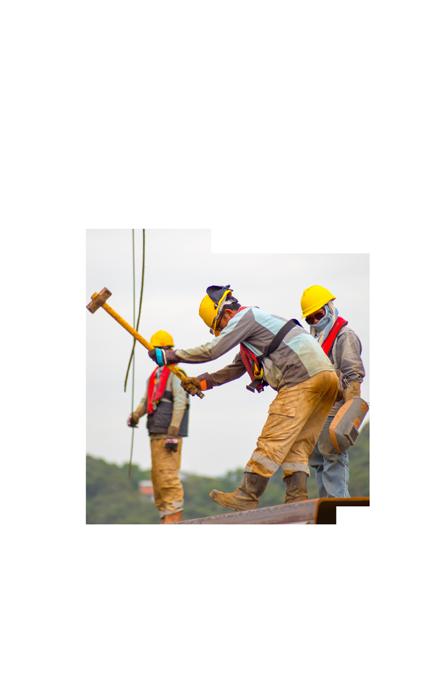
When New Zealand moved to the MMP system in 1993, setting the number of seats in parliament to 120, its population was just over 3.5 million. Now over 5 million, the number of seats have not changed, but the recommendation to freeze the 60:40 ratio of electorate to list seats, thus allowing the number of seats in parliament to increase with New Zealand’s population, has already been rejected by Justice Minister Paul Goldsmith.
It is one of 117 recommendations that have come out of an independent electoral review which was commissioned by the previous government.
Lowering the voting age to 16, allowing all prisoners to vote and stand for Parliament, and repealing the offence of ‘treating’ voters with refreshments and entertainment are other recommendations already ruled out by Goldsmith.
One recommendation which does look likely to be considered is a fouryear term. The government has already committed as part of the National-ACT coalition agreement to introducing the Constitution (Enabling a 4-Year Term) Amendment Bill, which if passed would be subject to a binding referendum.
In New Zealand, the longest a parliament can run is three years from the return of the writs for the previous election. At the end of this three-year period, unless it has already been dissolved, parliament expires.
The length of the parliamentary term must balance two objectives:
• Effectiveness: allowing parliaments and
More than 100 recommendations have been made to strengthen New Zealand’s democracy and the effectiveness of parliament, some of which have already been ruled out the current government – one that is still on the table is a four-year electoral cycle

governments enough time between elections to do their jobs. For governments, this means enough time to develop, consult on, and implement their policies. Parliaments, meanwhile, need time to scrutinise governments and examine legislation.
• Accountability: elections hold politicians accountable to the people they serve. The
ballot box provides the ultimate accountability. The term of parliament needs to be short enough to provide this opportunity regularly, but long enough for the public to be able to understand and assess the performance of the government and Members of Parliament (MPs). This accountability also helps to maintain trust in
public institutions and uphold the legitimacy of the democratic system.
The arguments between a three- or four-year term of parliament are finely balanced. There are legitimate concerns about whether the current three-year term is enough time for government, parliament, and MPs to be effective.
The arguments in favour of a four-year term – that it would improve the ability of

parliament to scrutinise the government, produce better laws and more effective governments – were strong arguments, in line with the review’s objectives.
On the other hand, there is no certainty that a four-year term will deliver the promised benefits when compared to a three-year term. A longer term would allow more time to develop and make new laws but might not improve the law-making process. Also, in the absence of greater checks on how governments exercise power, more frequent elections help voters hold governments to account.
Some experts consider that the introduction of
MMP has indeed shifted the balance of power between governments and parliament, increasing the ability of parliament to more effectively hold the government to account.
The recommendation
Holding a referendum on the term of parliament should be considered as one part of a package of recommendations.
Taken together, the recommendations aim to improve democracy in Aotearoa New Zealand. A greater gap between elections may be more acceptable to some people if other recommendations were adopted.
For example, the recommendation to lower the party vote threshold to 3.5 per cent will result in a more representative parliament.
The current party-vote threshold of five per cent is higher than it needs to be and lowering the threshold will broaden representation by making it easier for new parties to enter parliament, while still allowing for the formation of stable parliaments and effective governments. This recommendation could counter-balance less frequent elections.
Another recommendation to help level the playing field for newer parties is a setting a flat spending limit on advertising of $3.5
million for all parties, as well as a $30,000 cap on donations. Currently there are no restrictions on the amount that an individual may donate or loan to a party or candidate, and this risks enabling the exercise of undue influence through financial means.
Related to this is the recommendation that only individuals enrolled to vote should be able to make loans or donate to parties and candidates.
Click here for the full independent electoral review report

Safe Work Australia has published a model Code of Practice which will serve New Zealand operators well
The model code provides practical guidance for persons conducting a business or undertaking (PCBUs) on how to eliminate or minimise the risk of sexual and gender-based harassment at work so far as is reasonably practicable.
PCBUs must take a proactive, consultative and preventative approach to sexual and gender-based harassment whether it comes from colleagues, customers or the public, online or in person.
They must identify and assess the risks, eliminate or minimise them so far as is reasonably practicable, and review their control mea-

sures to make sure they’re working as planned. Managing the risks may mean changing the layout of your workplace, redesigning the work or the way
it is done. Training and policies alone are not effective or reliable controls.
You must consult your workers on the risks of sexual and gender-based
harassment as well as other psychosocial hazards.
Safe Work Australia recommends the model code should be read and applied alongside the Code of Practice: Managing psychosocial hazards at work.
Sexual and gender-based harassment often occurs with other psychosocial hazards and PCBUs must consider the interaction between these hazards when managing risks to the health and safety of workers and others.
Download the model Code of Practice: Sexual and gender-based harassment.
W i t h y o u r s u p p o r t w e c a n c o n t i n u e t o p r o v i d e p ra c t i c a l h e l p , c a r e a n d c o m f o r t .
A c c o m m o d a t i o n a n d h o m e v i s i t s a r e j u s t t w o o f t h e w a y s w e s u p p o r t N e w Z e a l a n d e r s a f f e c t e d b y c a n c e r.



 Barry Dyer Chief Executive Responsible Care NZ
Barry Dyer Chief Executive Responsible Care NZ
Today, chemical suppliers and their customers continue to adjust to the Covid operational environment.
They struggle with supply chain delays, the loss of experienced staff, frustration with unanswered queries to risk-averse authorities, inflexible and prescriptive regulations, rising compliance costs, diminishing resources and increasing public chemical safety expectations.
While 130,000 businesses are reportedly captured by the Hazardous Substances and Major Hazard Facilities regulations, the official mantra of “600-900 persons seriously harmed each year by unwanted exposure to chemicals in their workplace” presumably applies to all of the country’s 530,000 workplaces.
Increasing community concerns about vulnerability to unwanted chemical exposure and damage to our fragile environment places additional pressure on both suppliers and users of the chemicals.
We all need to sustain and improve our quality of life and these products must be safely managed throughout their life cycle.
Downgrading the flawed but effective HSNO Certified Handler requirement has inadvertently undermined an invaluable capability.
The action deprived businesses, particularly SMEs, of an immediate and recognisable source of workplace chemical safety and compliance advice -- a safe chemical handling capability and emergency response knowledge – critical when a chemical incident occurs.
PCBUs and SMEs must now devise their own solutions to ensure employees are competent to safely handle the chemicals with which they work.
Chemical industry leaders are moving away from relying on lagging indicators of safety performance in favour of identifying safer work practices and work-
places, by responding to workers’ suggestions about improvements.
Conscientious business operators can add value by sourcing accurate, cost-effective workplace chemical safety advice and compliance tools from their suppliers, industry partners and Responsible Care NZ.
A proven strategy is government agencies collaborating with proactive industry associations to best achieve workplace safety aspirations. The problem is that SMEs rarely join associations.
However, they all obtain their chemical requirements from suppliers and can benefit from product stewardship advice and cost-effective industry compliance initiatives.
Responsible Care NZ extols less regulation in favour of enabling business operators to be increasingly self-sufficient, using cost-effective products and services such as site compliance assessments and specialist training.
The focus is keeping people safe around the chemicals we encounter every day by adding value to businesses.
Responsible Care is a global voluntary chemical industry initiative developed autonomously by the chemical industry for the chemical industry.
Chemical suppliers continue to help customers achieve workplace chemical safety aspirations through product stewardship initiatives.
To help solve the in-house chemical compliance dilemma in New Zealand, Responsible Care NZ delivers specialist and cost-effective Certified Handler standard training, complete with a certificate.
Responsible Care NZ site compliance assessments are non-threatening, effectively capturing and assessing chemical safety performance in a variety of workplaces.
+64 4 499 4311
info@responsiblecarenz.com
www.responsiblecarenz.com
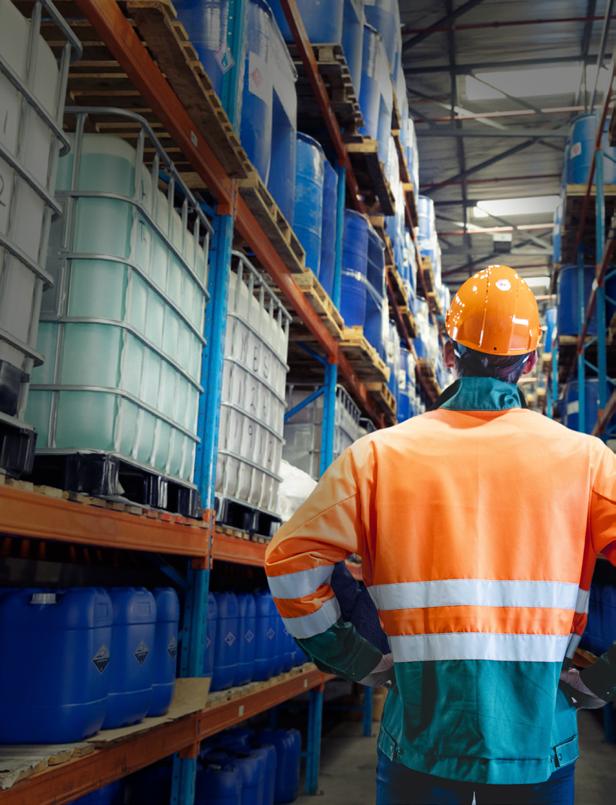




There is more than just the Health and Safety at Work (Hazardous Substances) Regulations to consider when it comes to hazardous substances and who they can be supplied to, Chemsafety Senior Hazardous Substances Specialist Janet Connochie says
We have seen recent activity from the EPA about hazardous substances that are only permitted to be supplied to workplaces.
At workplaces you would be forgiven for thinking that the Health and Safety at Work (Hazardous Substances) Regulations –HSW(HS) are all that you
need to consider, but for suppliers that is not the case.
The Hazardous Substances (Hazardous Property Controls) Notice includes a rule that some substances are restricted to supply to workplaces only. A supplier may only supply these substances to A workplace and only if they have written
notification that a competent person will accept responsibility for the substance, or
To an authorised person (someone who has an approval from the EPA to have the substance at a place that is not a workplace).
This is very similar to the tracking requirements – and the definition of competent
person is the same as that used in the tracking regulations.
What’s the issue that has arisen?
EPA has begun to communicate these requirements to importers and suppliers and this is now being passed down the supply chain.

The list of classes of substances that are restricted to workplaces only is similar – but not the same as – the list of tracked substances. The classes are shown below – there are also lists of specific substances that are added and excluded.
The classes causing the most concern from a supplier / customer perspective are below.
• 1C – Acute toxicity Category 3
• 7A – Carcinogenicity Category 1
The reason being is that these are not tracked, but found in a wide range of products. Also of note is that the lists of specifically included and excluded products are not the same – for example class 6.1B hydrochloric acid is in the not tracked list, but not in the not restricted to workplaces list.
Suppliers should be asking for written confirmation that there is a competent person – i.e. the name and work
address of the competent person(s). They should not be asking for your training records, nor is there such a thing as a “competent handler certificate”. Certified handlers are only applicable to explosives (some exceptions apply), fumigants and Class 6.1A and 6.1B toxic substances.
All persons handling hazardous substances in the workplace require training in accordance with regulation 4.5, so you should already have
a training process and records in place.
Nothing really, both the Hazardous Property Controls notice and the training requirements under Regulation 4.5 have been in place for over 5 years. EPA is bringing the requirements to the attention of suppliers, and have an information page for regarding this.
chemsafety.co.nz


Funding has been awarded to further develop an ‘AI guardian angel’ that makes roadworks safer for workers and road users
RUSH, a pioneering New Zealand technology company, together with Downer’s Transport & Infrastructure, has been awarded funding in the second round of the Waka Kotahi Hoe ki angitū – Innovation Fund to further develop the technology.
Using the R/VISION platform developed by RUSH and piloted in collaboration with Downer in 2021, the project uses computer vision machine learning – a specialised field of artificial intelligence that trains computers to interpret and understand visual information from the world around them.
Mobile AI Camera Units are placed around traffic
management sites to monitor critical risks and alert workers to make real-time adjustments via alerts, predictive analytics and auto-risk assessments.
According to RUSH Founder & CTO Danu Abeysuriya, the project aims to keep road workers and road users safe at roadworks sites. The technology supplements human-decision-making by providing workers with real-time data and predictive analytics crucial to making smart decisions that keep people safe.
“Our aim is to make this technology accessible for the entire industry, not just at roadworks sites across the country but for a range
of contractors, including small businesses and large infrastructure projects,” Abeysuriya says.
Waka Kotahi Future Transport Manager, Lee McKenzie, says the project shows great potential.
“We believe every road worker and road user should go home safely, and we’re proud to be supporting this, and other projects, that uphold this vision through Hoe ki angitū.
By partnering with innovators like Rush in collaboration with Downer, we can accelerate potentially transformational solutions to some of our biggest transport challenges.”
The integration of AI into operational safety is an ex-
citing development for the construction industry which has long awaited fresh innovation, says Murray Robertson Chief Operating Officer – Transport & Infrastructure, Downer Group.
“We understand the inherent dangers associated with working in the road corridor. R/VISION has the potential to act as a crucial safety net, providing our teams with the right information to make informed decisions on-site. It doesn’t replace the importance of human judgment, but rather complements it as another valuable tool in our toolbox,” says Robertson.
With the enactment of the Health and Safety at Work Act (2015) it became apparent that there was a need to assure customers that they comply the requirements of the Act in safety measures for fall arrest.
“We needed to have our system independently analysed, engineered and ultimately certified. This meant that not only did the individual components of the safety net fall arrest sys-
tem have to be tested, the performance of the safety fall arrest system as a whole also needed to be studied,” says General Manager Craig Daly.
A team at the School of Engineering and Technology at Massey University tested a variety of drop heights and weights, different bracket centres, various net sizes and points where the load strikes the net.
“It even tested nets of different ages and repaired
nets, with the results being collated and analysed to effectively confirm that our safety fall arrest system works,” says Daly.
“This enables PCBU’s to discharge their responsibilities in regard to the requirements of the in the use of a system that is without risk to the health and safety of it’s workforce.”
When the nets have been installed and inspected by a Safety Nets NZ team and a handover certificate
completed by our certified rigger, the client can then commence works above the safe area of the net.
“All of our safety documentation has been produced in such a format as to ensure that it complements the overall site safety policy and manual that the Principal Contractor is required to establish on all projects,” says Daly.
Click here to read inspection guidelines


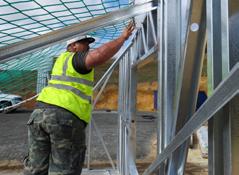

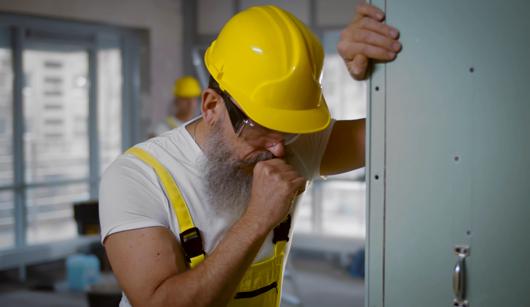
It is incumbent on PCBU’s to ensure that workers are not exposed to carcinogens and airborne risks
Worksafe NZ's Clean Air programme was their first targeted intervention on workrelated health. Their goal was to reduce the risk of respiratory ill-health caused by exposure to airborne contaminants in the workplace.
A key part of the programme is to raise awareness and eliminate or control the health risks of silica dust, organic solvents, welding fumes, wood dust, carbon monoxide and agrichemicals.
In New Zealand cancers and respiratory diseases from airborne substances account for at least 31% of total work-related harm and
an estimated 650 deaths per year. They account for 79% of the estimated 750 – 900 people who die annually from work-related health causes - Source: Worksafe NZ.
More information here: https://www.worksafe.govt. nz/topic-and-industry/ work-relatedhealth/ carcinogens-and-airbornerisks/ Whether you are an employer who needs respiratory solutions for employees or a welder, plumber, spray painter, asbestos worker, farmer or even a casual carpenter – LUNG PROTECTION IS VITAL!
It is incumbent on PCBU’s to ensure that workers are
not exposed to carcinogens and airborne risks. When the hierarchy of controls in risk management have been applied and risks remain, Respiratory Protection Equipment is one of the last lines of defence.
Choosing the correct type of respiratory equipment can be quite confusing, but here are a few simple guidelines to ensure that employers and workplaces make the right decision.
• Get advice from experts.
• Use a reputable supplier.
• Ensure the respiratory equipment complies with AS/NZS1716:2012.
• Use the right filters or opt for an airline system if necessary.
• Change filters regularly.
• Only use the filters supplied by the manufacturer of the respiratory mask to stay compliant.
• Get “fit tested”.
pH7 has the expertise and products to assist companies with their respiratory requirements. Follow pH7’s respiratory “fast facts” articles on LinkedIn, Facebook and Instagram for more insights.
For end to end solutions, contact us on 0800 323 223, email us at enquiries@ ph7.co.nz or go to www.pH7.co.nz


Leading providers of safety solutions for businesses working with hazardous substances
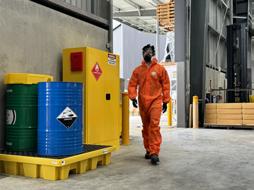




The team was forged by three friends working in the industry who realised that the key thing stressed building managers, business owners and landlords needed was to make a single call and get a reliable and qualified support team that would cover any aspect of facilities management.
The Rapid trio set down a business philosophy that “we will do what others can’t or won’t do “ and set about assembling a highly trained, efficient and safety-conscious team of professionals who get the job done right, the first time.
Today that service stretches from food manufacturers’ audit cleaning, all aspects of industrial cleaning, painting, building and floor safety management to anti-microbial and moss

worked in the industry for many
and mould treatments to prevent surface damage to roofs, ceilings, walls, floors and specialised equipment.
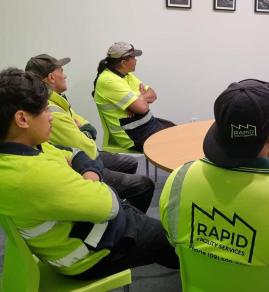

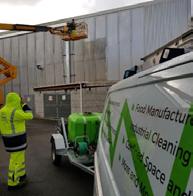

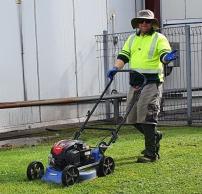

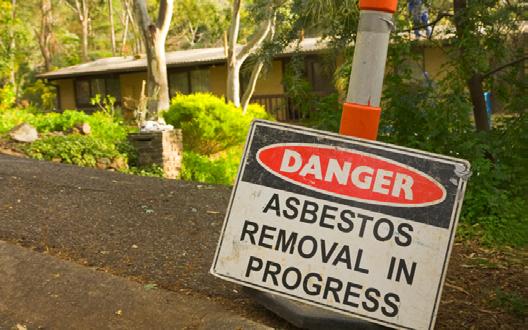
Asbestos remains the country’s number one work-related killer, with about 220 people dying each year from preventable asbestos-related disease
Two recent court cases serve as a reminder to tradies and businesses of the dangers, and how to manage the risks of the known carcinogen.
The latest WorkSafe prosecution involves Wilson Building Timaru Limited. The company was fined for the unauthorised removal of asbestos by the company director, which put workers at high risk of asbestos exposure over several days. The company did not seek an asbestos management plan from the
building owner at any point. The asbestos should have been removed by a licensed expert.
Earlier in the year, Inspired Enterprises Limited was sentenced over a case of poorly handled flooring containing asbestos. There was no asbestos management plan, and the customer’s quote did not mention the possibility of asbestos. Both cases highlight concerning gaps that fall well short of best practice.
“In New Zealand, businesses have a responsibility to manage the risks to their
workers associated with asbestos,” says the Head of WorkSafe’s General Inspectorate, Tracey Conlon.
WorkSafe requires asbestos management plans to be in place for workplaces where asbestos or asbestos-containing material has been identified or is likely to be present.
“The health consequences seen today are the legacy of historic exposure to asbestos, often while at work. Actions taken today will help prevent yourself, workers and others being harmed by asbestos-related
disease in the future,” says Tracey Conlon.
WorkSafe has a broad range of advice and guidance online about managing asbestos-related risks, including what businesses are required to do to manage asbestos exposure risks.
Read more about the case against Inspired Enterprises Limited
Read more about the case against Wilson Building Timaru Limited
Kevin Howard Stratford, who operates Stratford Logging, was convicted in the Nelson District Court and fined $56,000.
Over the course of 2021 Mr Stratford carried out tree felling in Takaka Hill at a site directly adjacent to State Highway 60.
WorkSafe was notified in August 2021 by an experienced tree feller that the work was being carried out with disregard for industry standards, in particular that trees were being felled very close to the road with no traffic management in place.
WorkSafe opened an investigation. An independent forestry expert who assisted WorkSafe’s investigation found felling techniques were of ‘very poor quality’, well below industry standards and posed a serious risk to all in the area.
Several trees had been cut in a way which increased the risk of ‘barberchairing’.
Barberchairing is an exceptionally dangerous situation where a tree splits vertically from top to bottom before breaking away. Workers on site also didn’t have the relevant qualifications do the work.
Watch a short video showing ‘barberchairing’
“The way work was done with no warning signage or traffic management put people at great risk, including innocent bystanders driving along the road,” says WorkSafe Regional Manager Juliet Bruce.
“There were steps Mr Stratford should have taken, including not felling trees within two lengths of a public road, putting in place temporary traffic management controls with authorisation of the Road Controlling Authority and ensuring all workers were

adequately trained. He was also required to notify WorkSafe before he began tree felling.”
WorkSafe issued Mr Stratford with four Prohibition Notices and 28 Improvement Notices since 2013 in relation to unsafe tree felling, failing to notify of tree felling work, workers having inadequate qualifications and having an insufficient health and safety system. Mr Stratford was also convicted in 1998 for failing to ensure the safety of an employee.
“There has been a huge amount of enforcement action against Mr Stratford to motivate him to keep people safe, but he persisted in his poor practices and the only option left for WorkSafe was to prose -
cute,” says Ms Bruce.
In sentencing Mr Stratford, Judge Jo Rielly was critical of his ‘dismissive attitude’, commenting ‘you are a person who has put your concerns around financial costs involved in completing work ahead of important safety considerations’.
WorkSafe has several pieces of guidance on its website related to tree felling:
• Approved Code of Practice for Safety and Health in Forestry Operations
• Treefelling Best Practice Guide
• Managing a Safe and Healthy Small Forest Harvest (WorkSafe Good Practice Guidelines)
Read more about Work-
Safe prosecutions
• Kevin Howard Stratford was sentenced at Nelson District Court on 23 January 2024.
• A fine of $56,000 was imposed.
• Kevin Howard Stratford was charged under sections 36(2) and 48(1) and (2) of the Health and Safety at Work Act 2015;
• Being a PCBU, failed to ensure, so far as was reasonably practicable, the health and safety of other persons, was not put at risk from work carried out as part of the conduct of the business or undertaking.
• The maximum penalty is a fine not exceeding $1.5 million.

The Commerce Commission has filed criminal charges against two construction companies and two directors for alleged bid rigging of publicly funded construction contracts
The charges follow a Commission investigation into allegations that the companies and their directors colluded to rig bids for infrastructure projects in Auckland. It is the country’s first-ever criminal prosecution for cartel conduct.
Commerce Commission Chair, John Small, says the criminal proceedings filed in the Auckland District Court send a strong message to businesses that
the Commission will not tolerate cartel conduct, and is prepared to lay criminal charges to enforce the law.
“Cartel conduct harms consumers through higher prices or reduced quality, and it harms other businesses that are trying to compete fairly. The criminalisation of cartel conduct in 2021 underlines just how serious and harmful this offending is.
“Bid rigging of publicly funded construction
contracts loads extra costs onto taxpayers and the New Zealand economy as conduct of this type undermines fair competition. The Commission will not hesitate to bring criminal proceedings in appropriate cases to ensure kiwis are getting the benefits of fair prices, quality services and more choice.”
What is cartel conduct?
A cartel is where two or
more businesses agree not to compete with each other by price fixing, allocating markets or customers, or restricting the output or acquisition of goods and services. Bid rigging is a form of price fixing and can also involve allocating markets or customers.
Bid rigging or collusive tendering is when there is an agreement among some or all of the bidders about who should win a tender or have an unfair advantage in
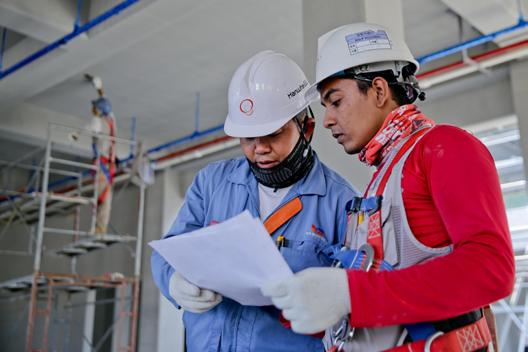
the tender. This may involve potential bidders not bidding for a tender to support the proposed winner or bidders may agree the prices that each party will bid. This often occurs in the form of “cover pricing.”
Cover pricing is where one or more parties submits a tender bid or bids at an inflated price with a view to increasing the prospects that another designated firm wins the tender. Such an agreement prevents open and effective competition and means procurers are unlikely to achieve best value for money for their business, customers, and in some cases, taxpayers.
Cartel conduct is prohibited under section 30 of the Commerce Act. As of 8 April 2021, cartel conduct is punishable with a term of imprisonment of up to 7 years, underlying just how serious and harmful offending of this nature can be.
• Make sure that you and your staff are familiar with the requirements of the Commerce Act. Keep records of who has at-
involved.
• Do not agree prices, discounts or any matters relating to price with your competitors (unless it is a specific sub-contract you are discussing).

tended training about the Act.
• Think carefully about who you are, or may be, in competition with, especially if sub-contracting is
• Do not agree to restrict output in any way, or to allocate customers or geographic markets between competitors.
• Do not exchange
pricing, how much you plan to produce in the future, customer information or which markets you sell into with your competitors.
• If you are approached by another business to discuss pricing, allocating customers, bids for contracts or restricting outputs you should raise an objection straight away. Leave the discussion immediately and contact the Commerce Commission.
• Review internal documents, policies and procedures for compliance with the Commerce Act and seek independent legal advice.
• If you become aware of anti-competitive conduct, contact the Commerce Commission immediately.
The gravity of New Zealand’s infrastructure deficit is well traversed. The conservative estimate is over $200 billion and the increasing frequency of climate related disasters alongside the pressures of growth will continue to add to this multigenerational challenge. Our infrastructure deficit is the legacy of historic underinvestment but also represents a significant opportunity for our economy, people and environment.
It's time for a mindset shift in how we fund, finance, procure and deliver our infrastructure. Structural reform is needed to supercharge the sector’s ability to deliver for New Zealanders. To deliver infrastructure faster and leverage the full benefit of projects, external partnerships need to be at the heart of a reset approach to infrastructure delivery.
In partnership, Infrastructure New Zealand and Brightstar look forward to presenting the upcoming Infrastructure Funding and Financing Conference on 26 March in Wellington. The gathering is essential for infrastructure professionals to come together and explore what the changed
environment will mean for infrastructure funding and financing, and how the sector can come together to pave the way ahead.
The first panel discussion will investigate the challenges inherent in structural reform and what new revenue tools for local government might mean. We will be joined by Jim Palmer, Chair of the Review Future for Local Government Review Panel and Anne Tolley, Commission Chair in Tauranga as we consider the way forward.
This session will include newly announced Partner at Russell McVeagh, Bevan Peachey, Infrastructure, Government and Specialised Finance at BNZ, Susan Lucking and Amelia East, Partner and Head of Advisory, Asia Pacific at HKA. The discussion will explore the future of a refined PPP, or community and economic partnership, model. They will provide key insights from Infrastructure New Zealand’s funding and
financing work and explore what change will mean for the sector.
Peter Colacino, Infrastructure Strategy and Transformation Lead –Australia, Mott MacDonald and former Chief of Policy and Research at Infrastructure Australia will host a fireside chat to discuss programmatic procurement to drive positive economic and community outcomes.
Colacino brings close to 20 years of experience in public policy and is an internationally recognized leader in policy and reform, having authored or contributed to more than 50 influential reports and publications on topics such as regional development, infrastructure, urban planning, market capacity, transport, funding and financing.
Bevan Peachey will also be facilitating a masterclass which offers a focused and comprehensive opportunity for participants to delve into the critical aspects of risk management in infrastructure projects. Participants will gain a foundational understanding
of the principles that underpin risk allocation in contracting for infrastructure projects.
Placed-based agreements for local government professionals
Local government professionals are encouraged to attend a second masterclass to gain practical takeaways that will enable them to navigate the complexities of place-based agreements effectively, fostering informed decision-making and strategic planning within the New Zealand landscape. There will be lessons and learnings from overseas, along with discussions of New Zealand’s opportunities and risks.
Facilitators are Patrick McVeigh who is the Practice Lead, People and Places and MartinJenkins alongside Linda Meade, Managing Director at Kalimena.
The Infrastructure Funding and Financing Conference stands as a testament to the collaborative spirit driving New Zealand's infrastructure towards excellence. We look forward to seeing you there. To view the programme visit brightstar.co.nz/IFF

26 MARCH 2024
TE PAPA, WELLINGTON
• Lessons from successful long-term agreements
• Challenges and opportunities of structural reform
• The future of public-private partnerships (PPPs) in New Zealand
• Alternative funding and financing tools
• Funding and financing climate resilient infrastructure and adaptation




SUSAN LUCKING
of Infrastructure, Government and Specialised Finance, BNZ



LEGGETT



Most New Zealand businesses, whether large corporates, sole traders, or self-employed, are classed as PCBUs.
A PCBU must, so far as is reasonably practicable, provide and maintain a work environment that is without health and safety risks. The work environment includes:
• the physical work environment, including lighting, ventilation, dust, heat and noise
• the psychological work environment, including overcrowding, deadlines, work arrangements (eg the effects of shift-work and overtime arrangements) and impairments that affect a person’s behaviour, such as work-related stress and fatigue, and drugs and alcohol.
PCBUs are responsible for providing and maintaining
safe plant and structures. This includes machinery, vehicles, vessels, aircraft, equipment (including personal protective equipment), appliances, containers, implements, tools, buildings, masts, towers, frameworks, pipelines, quarries, bridges, underground works (including shafts and tunnels) and any component of one of these items or anything fitted or connected to one of these items. PCBUs must also ensure the safe use, handling and storage of plant, structures and substances.
Providing safe systems of work is also a PCBU’s responsibility, as is providing any information, training, instruction or supervision that is necessary to protect
all persons from risks to their health and safety which may arise from the work of the business.
It is also a PCBU’s job to monitor the health of workers and the conditions of the workplace.
Another responsibility of a PCBU is to provide adequate facilities for the welfare of workers when doing work for the business, including ensuring access to those facilities. This also applies to providing healthy and safe worker accommodation when appropriate.
Click here for more information.
PCBUs that fail to meet their health and safety obligations are putting people at risk and can face prosecution. The following are recent examples of health and safety failures by PCBUs and the resulting consequences.



Fine: Inspire Building: $30k | Thorne Group: $210k
Reparations:To Ethan Perham-Turner’s family: $130k | To Coworker: $15,072
WorkSafe New Zealand is calling on the construction sector to “up its game” after a teenager was killed just four months into his apprenticeship
Ethan Perham-Turner was killed when timber framing weighing 350 kilograms fell on him at a residential building site in Ōmokoroa in March 2022. The 19-year-old was just four months into an apprenticeship with Inspire Building Limited at the time. A WorkSafe investigation found the risk was heightened by the framing being manually installed around the site, and a temporary support brace being removed just prior to the fatal incident. When one frame knocked another, it fell on the teenage apprentice.
Inspire was providing building labour for the main contractor, Thorne Group. Both were charged for health and safety failures in relation to the death. The businesses should have consulted each other on the framing installation plan, and ensured a mechanical aid (such as a Hiab crane truck) was used.
“The death of a worker so young is an indictment on the construction sector. Ethan was new to the job, and new to the task of manoeuvring framing. He should have been provided with what he needed to be
safe,” says WorkSafe’s area investigation manager, Paul West.
“The safest way would have been to mechanically lift the framing into place, given its weight. This can come at little to no extra cost. In this case, the supplier delivering the framing had a Hiab and could have lifted it into place if asked.
“The high number of deaths and injuries tell us construction is a very dangerous industry. WorkSafe has seen other similar incidents where workers handling large or heavy frames
have been paralysed or killed. It is unacceptable that companies are not identifying the risks and providing workers with a safe workplace. We can only hope the death of a very young apprentice might motivate the step change required to improve the sector’s health and safety performance,” says Paul West.
Read safety alert on installing frames

Fine: $180,000 | Reparation: $110,000 |
Max Fine: $1.5m
When there is no obvious safe way to work, it’s best to stop, reassess, and involve experts to develop a new approach – rather than attempting to adapt things on the fly, says WorkSafe’s area investigation manager, Danielle Henry
The death of a 21-year-old in the construction sector shows how easily stopgap measures can endanger workers.
Aidan Paszczuk was removing steel beams when one fell and killed him at a Newmarket construction site in October 2021.
A WorkSafe investigation found that workers devised an ad-hoc way to get the job done when their original method could no longer be used. Unfortunately, they did not have access to safetycritical information about the security of the 500-kilogram beam. When Mr Paszczuk stood on a stack of five
wooden forklift pallets to use an angle grinder, the beam fell on him.
The employer Grouting Services Limited (GSL) should have carried out an effective risk assessment to protect workers, and has now been sentenced for its health and safety failures. Not stopping for a short amount of time to come up with an alternative safer method cost a family their loved one, and affected productivity on a major construction worksite for days and weeks afterwards. Getting workers home healthy and safe must always be the top priority,
especially on fast-moving and dynamic construction sites.
A separate WorkSafe prosecution against CLL Service and Solutions Limited involved a crane toppling at the same busy Newmarket construction site a year prior to the death of Aidan Paszczuk. Sadly, the crane incident was not heeded as the site safety warning that it could have been. The risk of serious harm and death in the construction sector is well known, and WorkSafe is committed to ensuring businesses uphold their responsibilities for worker
health and safety.
Read more from WorkSafe on construction safety

‘Not the place for childcare’: forklift hits five-year-old
Fine: $7,000 |
Reparation: $25,000 |
Max Fine: $1.5m
A workplace has been fined $7,000 after allowing an underage driver to get behind the wheel of an unsafe forklift whilst a young boy was left unsupervised
When childcare fell through, the boy was taken to the orchard in January 2022 by his grandparents who worked there. He was told to stay inside the packhouse on a couch. Unfortunately, he wandered from that spot and into the path of a reversing forklift being driven by a 14-year-old worker.
The victim survived but suffered significant complex fractures to his hip bones and was hospitalised for a month. The orchard owner has now been sentenced for health and safety failures. A WorkSafe investigation found the victim was under limited supervision as
the caregivers were busy working. The forklift was poorly maintained with no basic safety features like reversing lights, mirrors, flashing lights, or a horn. The driver was underage, and the site had no written traffic management plan for forklift use.
“Naturally children want to explore, try new things, and push boundaries. As we head into the holiday season, this case is a reminder that children are always at risk on worksites and should not have been present,” says WorkSafe’s area investigation manager, Paul Budd.
It was common for the
young driver to be behind the wheel, and the owner had not done enough to establish his age. Businesses must remember that workers under 15 are not allowed to drive vehicles on worksites.
Risk management by the business was verbal and informal because of language barriers.
“It’s not good enough to say that your risk management is verbal because employees cannot always read English. Translating your safety information for workers, if necessary, goes a long way to keeping them safe.”
“Better traffic management would also have made a
big difference to safety. This could have included exclusion zones to separate vehicles from people, the use of barriers when operating the forklift, clear signage, and separate entry and exit points for people and vehicles,” says Paul Budd.
Children are now prohibited from the orchard during operating hours, and the victim has made a full recovery.
Read more about young people in the workplace
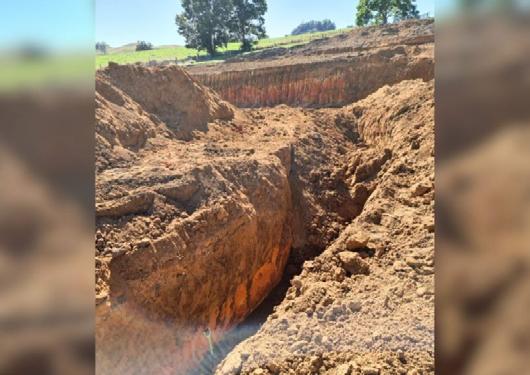
Worker rescued from trench collapse
Fine: $275,000 | Reparation: $45,000 | Max Fine: $1.5m
Extremely poor on-site safety has been deemed the cause of an incident which nearly buried a worker alive, leaving him injured both physically and mentally
Two workers were on a job at a farm near Te Kuiti in February 2021. One was operating a digger and the other was doing measurements inside a trench, which was three metres deep and two metres wide. When one of the side walls gave way, one of the workers was engulfed –leaving only the top of his head visible.
The rescuer initially used his hands to clear the dirt away so the victim could breathe, and then used a spade until he could pull him out. The victim suffered a collapsed lung, a broken rib cage, a broken sternum, and a broken collarbone. He now also lives with posttraumatic stress disorder (PTSD) because of the
incident.
The employer, R&L Drainage Limited, has now been sentenced for its health and safety failures.
A WorkSafe investigation found on-site safety was of an extremely poor standard. The trench had been built with a flat floor and steep vertical sides, rather than shored up with shields or battered into a safe slope to keep the sides stable. There had also not been any geotechnical assessment of the site to check the soil stability before work began.
R&L Drainage did not have a safe system of work in place for the job, and did not provide enough information, training, or supervision to protect workers from the risk of a trench collapse.
The company also did not notify WorkSafe, as required for any excavation deeper than 1.5 metres and when a worker is intended to be in the trench.
“There’s a right way and a wrong way to do excavations – and cutting vertical sides to three metres deep then sending a worker in is certainly not the way. This was a death trap and the victim literally had to run for his life,” says WorkSafe’s area investigation manager, Paul West.
Although you might be working out of sight in a remote rural location, this should give you more reason than ever to play it safe and follow the well-established rules for this type of work.
“Anyone digging such a deep trench should be aware of the possibility of collapse and should take proper precautions. We know how to dig trenches safely – it’s not hard to take the necessary safety measures.
“While victims can heal from their physical injuries, the mental toll can have a longlasting impact on individuals and whānau – as it has in this case. WorkSafe expects employers to look after both the physical and mental wellbeing of their workers in the aftermath of any workplace incident,” says Paul West.
Read more about excavation safety





New Zealand, we’ve got some exciting news
Our brand-new Quest on Cambridge is opening this November. Enjoy introductory rates from $135 per night for stays from 15th November 2023 to 14th January 2024*.
We’ve replaced almost all single-use plastic shampoo, conditioner and bodywash bottles with dispensers - removing 3.68 tonnes of plastic out of circulation. We’re also recycling old soap bars into new ones together with Soap Aid.
Find out more at soapaid.org
*Rates start at $135 for a studio and $155 for a 1-bedroom apartment all booked via the Quest App and the Quest website. All bookings must be for stays between November 15th 2023 to January 14th 2024 to qualify for the introductory rate.